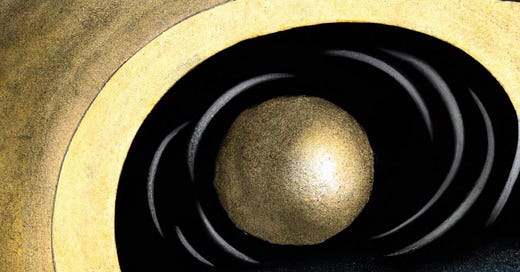The big kerfuffle of the moment in the science-y, media-ish corners of social media that I inhabit concernes an article by Natalite Wolchover in Quanta with the title “Physicists Create a Wormhole Using a Quantum Computer.” This is a report on the paper in Nature with the not-much-less-inflated title “Transversable wormhole dynamics on a quantum processor.” The argument mostly centers around the claims being made by those titles, which have been referred to as basically everthing on the spectrum from “fascinating breakthrough” to “complete bullshit.”
The gist of the whole thing, to boil Wolchover’s long and well-reported piece down to a single paragraph, is that a group combining a bunch of particle physicists with some quantum computing researchers from Google has done an experiment where they use a smallish number of qubits on one of Google’s quantum processors to carry out a sequence of operations that that moves state information from one single qubit out into the whole network, and then back to a single qubit again. This process can also be described in very different mathematical language, in which case it looks like a highly simplified version of what happens when you send something into one end of a wormhole connecting two points in spacetime, and recover it at the other.
The source of the controversy is the number of qualifiers that fall into that description of the process. That is, is it really sensible to say that the physicists have “created a wormhole” when they’ve simulated a simplified model of a process with an alternative description that maps to a model of a wormhole? The authors and editors of the pieces reporting the work obviously feel that that’s a defensible description of the work; a lot of other physicists think it’s somewhere between “a bit much” and, well, “utter bullshit.”
I’m personally in the “That’s a bit much…” part of the range. It’s a clever experiment, and I’m old enough to retain some residual sense of wonder at the very thought of an experiment that networks together nine well-characterized qubits and runs them through a complicated set of gates like this. And Wolchover’s piece is very thorough and admirably clear about what they actually did.
At the same time, this is at least one level of abstraction away from something I would personally describe as “creating a wormhole.” I totally understand why people who need funding to continue their research on simulating a model of an analogue of a wormhole would frame it that way, and don’t really fault them for doing so. I am going to roll my eyes at it a bit, though.
The thing that really jumped out at me about this, though, was the powerful sense of déjà vu I got from the whole thing. A lot of the online discussion felt like a flashback to the String Theory Wars circa 2006, when Lee Smolin published his broadside against string theory, and everybody in physics blogdom spent months arguing about it. Some of the same people are still involved— Wolchover has a bunch of quotes from Leonard Susskind, one of the most prolific defenders of string theory, and several of the other people are familiar to me from that era. In an “Oh, yeah, they would say that…” sort of way.
(I’ll admit to a little morbid curiosity about what a certain infamous Slavic theorist might be saying, but don’t want to go looking for it…)
This fits with a more general trend of me looking at social media and feeling like we’re just endlessly recapitulating stupid arguments that we had back in the Golden Age of Blogs. A lot of the #discourse around “cancel culture” and “wokeness” feels exactly like the “New Atheist” era arguments about whether it was a moral imperative to actively be the biggest dick possible to anyone who mentioned religion. The current kerfuffle is one of a shifting group of arguments about hyping and misrepresentation that seem like periodic recurrences of the arguments about “framing” of scientific results that swept through ScienceBlogs from time to time. And there’s a kind of middle-school dynamic to some of the drama around people leaving Twitter and setting up alternatives that’s reminiscent of the back-channels we used to have, and not in a good way.
This may be just me getting old, but I definitely feel a certain Sisyphean vibe around a lot of this. We’re pushing the same stupidly argumentative rock up the same dumbass hills that we were fifteen years ago, only with tighter character limits and more animated .gifs.
Anyway, just like back in the day, my feelings about this are extremely lukewarm, to wax oxymoronic. I think the headlines of these pieces are a bit much, but also far from the worst crime ever perpetrated against scientific publishing. And beyond that, I’m pretty much happy to sit this out.
So, there’s your “Old Man Yells at Cloud” content for the week. Here’s a button:
And if you want to argue passionately one way or the other, or just join in Remembering Some Guys, the comments will be open:





Best subtitle of the year.
Most of the popular public will read that headline and the summaries from others and conclude that scientists have made real progress in creating a real wormhole capable of sending matter through in our universe like in Interstellar or other sci-fi works. That is utter bullshit. Nothing was done here that made *any* progress on that front. Nothing was actually learned other than - yep, the math checks out - but the funding agencies will note the general reaction from the populous who think something actually was learned. In other words, it is a scam on the general public and these kinds of scams do add up to the general public being *deservedly* skeptical when scientists request funds in the future.